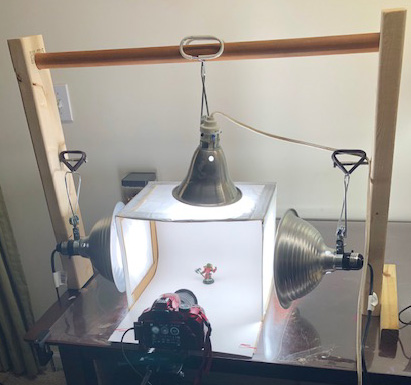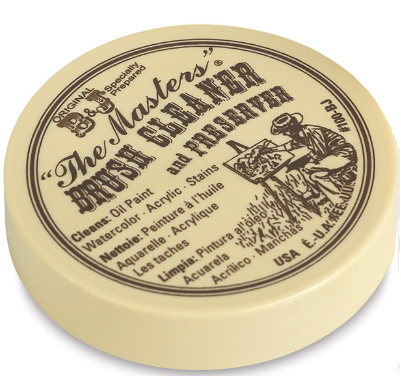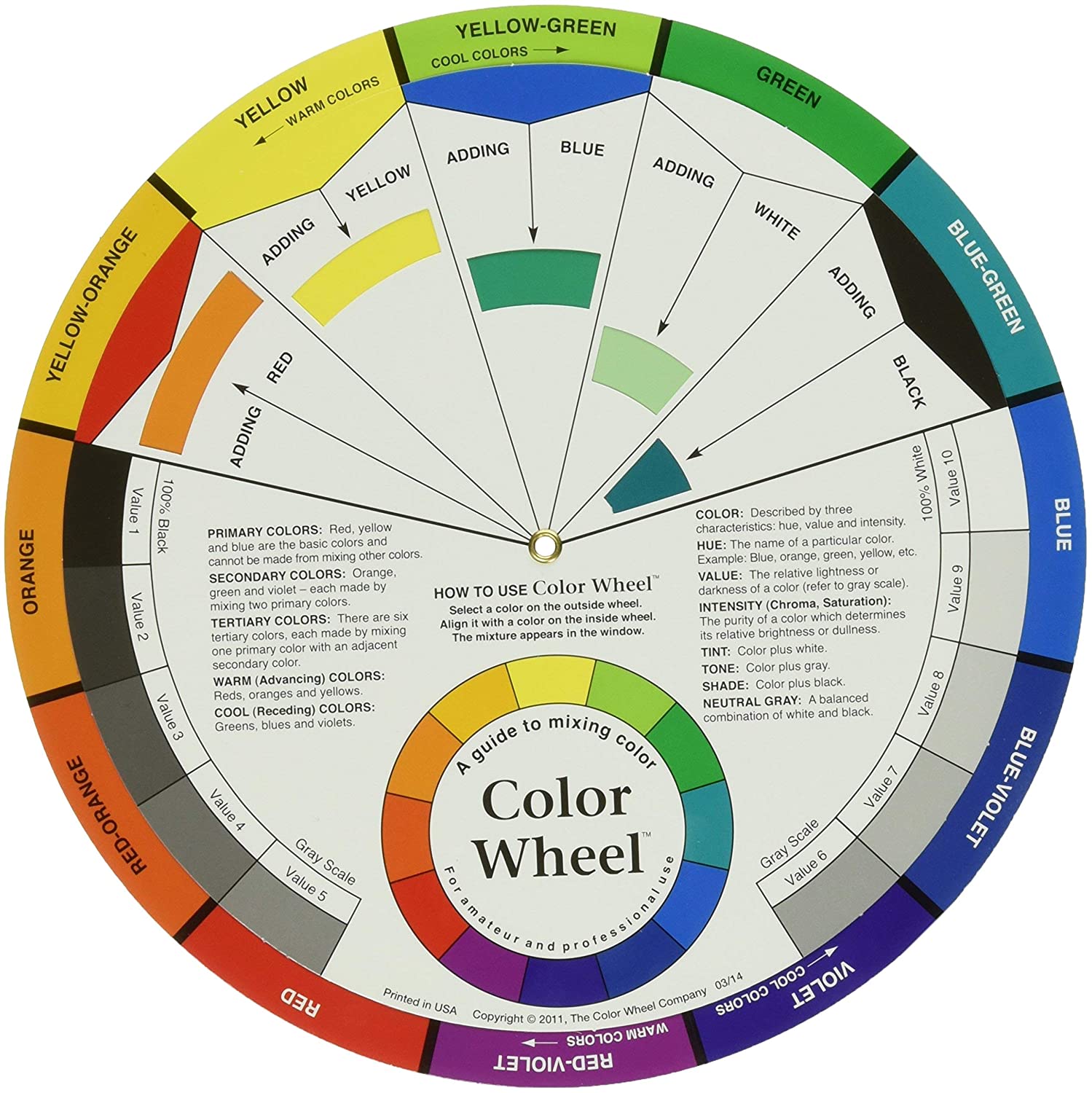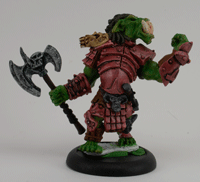 camera charged and on line with table, short lens on bristol sheet. Mini on (X). Transfer to pics bin, open with PS, crop, edit, save to web as JPG (Very High, 80 quality, new width 1680, new height 1050 (whichever is lowest.) Save to web as Gif width 200 for thumbnail. save to /images/mini pics/
camera charged and on line with table, short lens on bristol sheet. Mini on (X). Transfer to pics bin, open with PS, crop, edit, save to web as JPG (Very High, 80 quality, new width 1680, new height 1050 (whichever is lowest.) Save to web as Gif width 200 for thumbnail. save to /images/mini pics/
Clean Prep and Prime
Primer notes: Krylon Fusion is primer and paint, works for metal well. Do not use on Bones PVC minis. Army Painter Primer is solid, works on everything. Prime in lower humidity and temp, nice day = nice prime. Distance from model is key, follow directions and try a test rock every time. Shake 2 minutes, set up spot outside. Spray across, don't start on the figure, start off and walk it across the mini. Shake between, and watch particle build up. Primer on humid days, or old primer, will spray tiny chunks of paint. It will look like sandpaper on the mini. You can brush the mini with a dry tooth brush and remove "some" of the texture without removing the primer. It works for areas you want to be shiny, it will buff up before you apply first base coat. Test primer before every job, prime a rock and toss it.
Still love Gesso for touchup, but I need to find a better way of priming. My way is too weather dependent. Try some new Gessos this summer.
GUNK = 5:4:1 H2O: Flow aid: Retarder - currently using Liquitex Flow Aid (diluted 20:1 H20:Flow) and Liquitex Slow-DRI Fluid Retarder. Base coating is best done in layers, with a thin coat several times. Thick coats fill gaps, and make a great sculpt look average.
Brush care: Don't ever stand up a brush in a water cup, the bristles will form a hook, and it can't be fixed. If you are done with a brush: clean out the paint, dip in water and wipe on paper towels. Clean till nothing wipes off, dip it in the water cup, and leave it on the cup sideways till it's time to clean. Between colors same. End of the session, clean cup, palettes, in sink, using a sponge impregnated with prior dawn soap. Clean the brush in palm, under running water, not too hot (bristles glued in brush can come loose.) Wipe brush in B&J Brush Cleaner. 
I clean brushes with B&J every time I use them. I gunk them again after cleaning them, and shape the brush head and leave it to dry with the cleaner on it. If I come back to the brush five years later, it still has a good point. Clean a brush like you paint with it, don't crush the bristles. Don't leave your tips touching anything, dry or wet. It will save your brushes for years.
The PVC plastics used by Reaper for their Bones minis are hydrophobic. You can prime them with a primer that does not contain Acetone. Most spray primers do contain acetone, and acetone melts pvc. I use Army Painter primer for Bones. If you do not prime Bones, you can paint them, however you cannot use thin paint for base coats. You must use thicker paints, with low additives. Is the mini super important? Prime it. Is the mini for your daughter to paint 1 entire color? Skip the prime.
Here's some gems:
- There is always paint on the brush. You think it's gone, you want to refill it. Don't. There's paint on the brush.
- Opacity is more important than shades. Don't mix up three shades of paint. You can't duplicate it next week, and it's a waste of paint.
 One color, thin, and only layer portions of it, will get to whatever shade you want. Remember this when basecoating, as opacity is a factor of whatever color you are painting over. Side note: Always use dark basecoats under metallics.
One color, thin, and only layer portions of it, will get to whatever shade you want. Remember this when basecoating, as opacity is a factor of whatever color you are painting over. Side note: Always use dark basecoats under metallics. - Do shadows with the complement (mixed into the basecolor) of the highlight color.
- Saturated, Light, Warm colors draw the eye first. So make the Action part of the mini light, bright, or warm to draw the eye. Warm colors are daylight or sunset. Red Violet - Red - Orange - Yellow. Cool colors are gray or overcast days. Yellow-Green - Green - Blue - Violet. GET A COLOR WHEEL.

- Pick a main color, then the other colors react to that color. Warm to cold, light to dark, complementary, etc. Muted first color, mute the second.
- Glaze = super thin. Drop paint, drop matte medium (glazing liquid currently) 5 drops gunk, more water. It should be translucent over type. Keep crap typed documents around to test washes and glazes. It should run off the side of the palette wall. Glaze has matte medium in it, washes do not. Matte medium makes it act like paint.
- Blow hard on bubbles. They will go away. Don't blow on washes, obviously. Bubbles are preventable.
- Use a larger brush than you are comfortable with. A small brush may look like a needle, but you just need a good tip on a larger brush. If the brush is tiny, it can't hold any paint, and the paint will dry out under the hot lamps you are holding the mini 2 inches beneath.
- Don't use a palette. You have to clean a palette after each session, just use wax paper. A 5 by 5 inch sheet of wax paper holds paint well, and you just let it dry afterwards. You already have to clean brushes and a water cup, why clean a palette too? I use the wax paper several times, both sides, till it's tossed and you break out a new one. I hold them down with coins, and keep a stack of 5x5's on the side. Do use a wet palette, that thing rocks.
- Paint that comes in pots sucks. You can paint right from the pot, but who does that? I add thinner, and slow dri retarder to paint, so I have to have a palette knife around to move paint out of the pot. Good thing most paint comes in droppers.
- Use canvas paint for dry brushing. It's meant to be dry, no need to thin it.
Things to get better at:
- Be able to wash without making it look dirty. Washing with thin paint leaves a dark ring if you leave too much liquid in the crevasse. Be able to wash into creases without leaving a dirty ring ever. --> See wash test below.
- Blend better. Spit blending > glazing blending > wet blending. But, you have to get better at all of them.
Wash Experiment 6-6-20
I am doing several sample washes over the same basecolor (P3 Menolith White Base.) Bases are made from Souffle Sculpey (300 for 20 minutes at least) and Greenstuff. Primed with Krylon Fusion. Side Note: Paint was super hydrophobic. Paint went on super easy on another K Fusion primed model, perhaps my primer is going bad.
- Expected outcomes:
- Golden paint leaves coffee rings because it has larger pigment chunks.
- Wet the area first with water to reduce coffee rings.
- Soap and flow-aid reduce the co verage of high points.
- Tap water < distilled water.
- Ink is transparent, and is better for glazing than washing.
1: Armor wash, tap


Dirty, wash stained the high points, clear coffee stains in holes after drying. High concentrations and low concentrations look the same shade. Armor wash has adhesion issues. It doesn't shade the walls of the hole, while you can clearly see its on there wet.
2: VD, tap


Dirty, lower areas do look more shaded. Golden at least offers adhesion to the hole wall edges.
3: Armor wash, dist


Dirty, less shade on high spots. You can see shaded areas in the center of the holes, with the edges lighter. Clearly the paint dried in the middle, not on the edges. Ruins the shadow look. Armor wash must have ink as it's acrylic color.
4: VD, dist


Dirty, still some rings. Same issue as 1, with shade equal in holes and channels. Holes should be higher shade than channels. At least it did shade the edge walls of the holes better than 3.
5: Armor wash, dist, wet area first


Dirty, lot of shade on high points. Wash clearly dried in the middle of areas, with almost no shading of edges. Probably too much water involved, it broke down the acrylic binder and the
6: Armor wash, flow in Gunk


Least Dirty so far. Paint clearly fell off the high points and adheared to the edge walls of the holes. Considering what 5 looked like, this is a huge improvement. Flow aid gets a plus one.
7: VD, dist, plus a toothpick tip of Dawn soap


Dirty, looks like the wash covered everything. Really looks more like a glaze than a wash. Look into dish soap vs flow-aid properties.
8: Liquitex Transparent Burnt Umber ink, dist


Very Dirty. Looks like a glaze, with shade just as dark on the high points as the low points. If you are after a wash, this is not what you want. It did adhere to the hole edge walls well.
9: VD, dist, wet area first, plus a toothpick tip of Dawn soap


Golden plus soap makes the wash behave like a glaze. It is the same color high and low. Very little difference only edges and high points.
